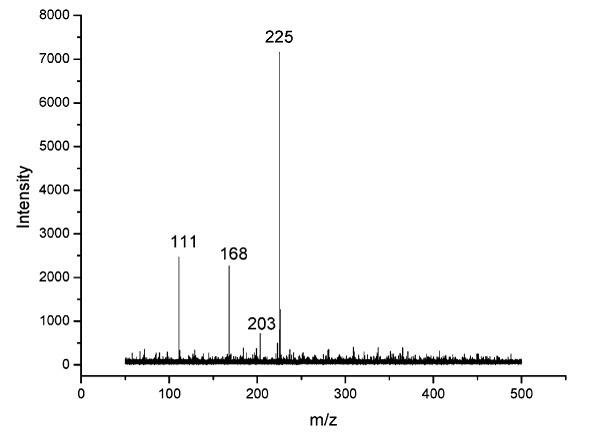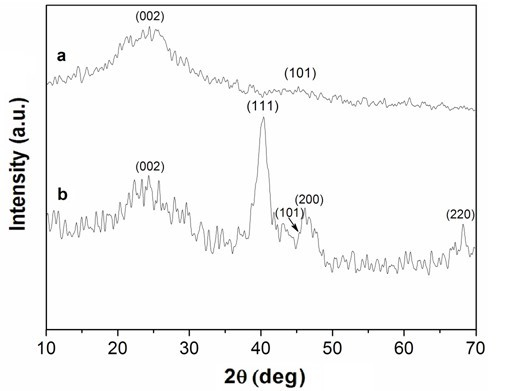Graphene matrix and application of graphene matrix in matrix-assisted laser desorption/ionization-time of flight-mass spectrometry detection
A matrix-assisted laser and time-of-flight mass spectrometry technology, which is applied in the field of analysis and detection, can solve the problems of difficult sample analysis, time-consuming and labor-intensive, limited monitoring, etc., and achieves the effects of strong versatility, high wear resistance and low cost.
- Summary
- Abstract
- Description
- Claims
- Application Information
AI Technical Summary
Problems solved by technology
Method used
Image
Examples
Embodiment 1
[0064] Embodiment 1: Method for detecting mixed amine samples such as spermine, spermidine, putrescine, etc.
[0065] (1) The instruments and reagents are: BIFLEX III MALDI TOF mass spectrometer (Bruker Company); nitrogen laser with a wavelength of 337 nm, adopting the working mode of delayed extraction and reflection of ions, positive ion detection; the collected The data were processed with Flexcontrol 2.2, data analysis software Flex Analysis 2.4, mass spectrometry imaging software Flex Imaging 1.0, differential analysis software Clin Protools 2.0 and other software;
[0066] (2) Prepare a graphene nanosheet coating on the carrier, and dry it with gas for later use;
[0067] (3) Immobilize the carrier on the MALDI target;
[0068] (4) After the sample solution of mixed amines (equal molar ratio) such as spermine, spermidine, putrescine, etc. dispersed in N,N-dimethylformamide solvent is added dropwise to the surface of the graphene film or coating, the sample and the matri...
Embodiment 2
[0069] Embodiment 2: the method for detecting annulene sample
[0070] (1) The instruments and reagents are: BIFLEX III MALDI TOF mass spectrometer (Bruker Company); nitrogen laser with a wavelength of 337 nm, adopting the working mode of delayed extraction and reflection of ions, positive ion detection; the collected The data were processed with Flexcontrol 2.2, data analysis software Flex Analysis 2.4, mass spectrometry imaging software Flex Imaging 1.0, differential analysis software Clin Protools 2.0 and other software;
[0071] (2) Prepare a graphene nanosheet coating on the carrier, and dry it with gas for later use;
[0072] (3) Immobilize the carrier on the MALDI target;
[0073] (4) After adding the annulene sample solution dispersed in xylene solvent onto the surface of the graphene coating, the mixed crystals formed by the sample and the matrix are secondary crystallized, and the sample to be analyzed is prepared after the solvent evaporates, and the laser analysis...
Embodiment 3
[0074] Embodiment 3: the method for detecting squalene sample
[0075] (1) The instruments and reagents are: BIFLEX III MALDI TOF mass spectrometer (Bruker Company); nitrogen laser with a wavelength of 337 nm, adopting the working mode of delayed extraction and reflection of ions, positive ion detection; the collected The data were processed with Flexcontrol 2.2, data analysis software Flex Analysis 2.4, mass spectrometry imaging software Flex Imaging 1.0, differential analysis software Clin Protools 2.0 and other software;
[0076] (2) Prepare a graphene nanosheet coating on the carrier, and dry it with gas for later use;
[0077] (3) Immobilize the carrier on the MALDI target;
[0078] (4) After the squalene sample solution is dispersed in N,N-dimethylformamide solvent and added dropwise to the surface of the graphene film or coating, the mixed crystal formed by the sample and the matrix is secondary crystallized, and the solvent is volatilized. The samples to be analyzed ...
PUM
| Property | Measurement | Unit |
|---|---|---|
| Thickness | aaaaa | aaaaa |
| Molecular weight | aaaaa | aaaaa |
Abstract
Description
Claims
Application Information
 Login to View More
Login to View More - R&D
- Intellectual Property
- Life Sciences
- Materials
- Tech Scout
- Unparalleled Data Quality
- Higher Quality Content
- 60% Fewer Hallucinations
Browse by: Latest US Patents, China's latest patents, Technical Efficacy Thesaurus, Application Domain, Technology Topic, Popular Technical Reports.
© 2025 PatSnap. All rights reserved.Legal|Privacy policy|Modern Slavery Act Transparency Statement|Sitemap|About US| Contact US: help@patsnap.com



